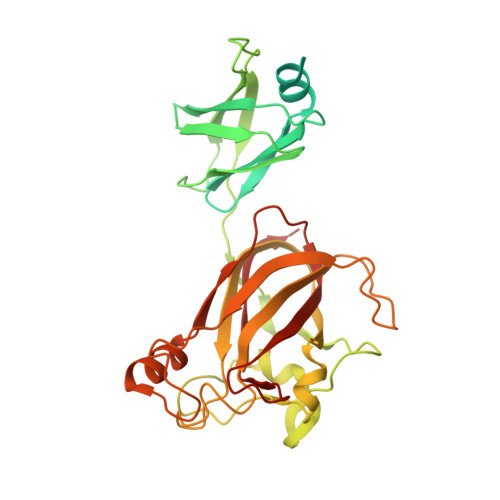Analysis of Two SusE-Like Enzymes From Bacteroides thetaiotaomicron Reveals a Potential Degradative Capacity for This Protein Family.
Stevenson, J., Ngo, M., Brandt, A., Weadge, J.T., Suits, M.D.L.(2021) Front Microbiol 12: 645765-645765
- PubMed: 34149636
- DOI: https://doi.org/10.3389/fmicb.2021.645765
- Primary Citation of Related Structures:
7M1A, 7M1B - PubMed Abstract:
Bacteroides thetaiotaomicron is a major constituent of the human gut microbiome and recognized as a prolific degrader of diverse and complex carbohydrates. This capacity is due to the large number of glycan-depolymerization and acquisition systems that are encoded by gene clusters known as polysaccharide utilization loci (PUL), with the starch utilization system (Sus) serving as the established model. Sharing features with the Sus are Sus-like systems, that require the presence of a specific membrane transporter and surface lipoprotein to be classified as Sus-like. Sus-like import loci are extremely varied with respect to any additional protein components encoded, that would effectively modify the functionality of the degradative and import action of each locus. Herein we have identified eight Sus-like systems in B. thetaiotaomicron that share the feature of a homologous SusE-like factor encoded immediately downstream from the transporter/lipoprotein duo sus C/D. Two SusE-like proteins from these systems, BT2857 and BT3158, were characterized by X-ray crystallography and BT2857 was further analyzed by small-angle X-ray scattering. The SusE-like proteins were found to be composed of a conserved three domain architecture: a partially disordered N-terminal domain that is predicted to be proximal to the membrane and structurally homologous to an FN3-like bundle, a middle β-sandwich domain, and a C-terminal domain homologous to family 32 carbohydrate-binding modules, that bind to galactose. Structural comparisons of SusE with SusE-like proteins suggested only a small structural divergence has occurred. However, functional analyses with BT2857 and BT3158 revealed that the SusE-like proteins exhibited galactosidase activity with para-nitrophenyl-β-D-galactopyranoside and α-(1,4)-lactose substrates, that has not been demonstrated for SusE proteins. Using a series of domain truncations of BT2857, the predominant β-D-galactosidase activity is suggested to be localized to the C-terminal DUF5126 domain that would be most distal from the outer membrane. The expanded functionality we have observed with these SusE-like proteins provides a plausible explanation of how Sus-like systems are adapted to target more diverse groups of carbohydrates, when compared to their Sus counterparts.
Organizational Affiliation:
Department of Chemistry and Biochemistry, Wilfrid Laurier University, Waterloo, ON, Canada.















